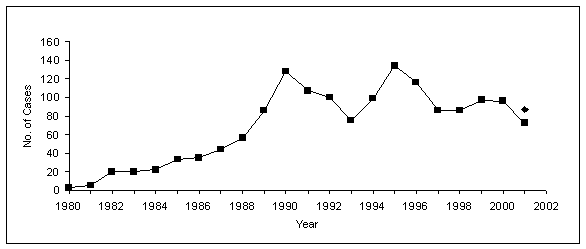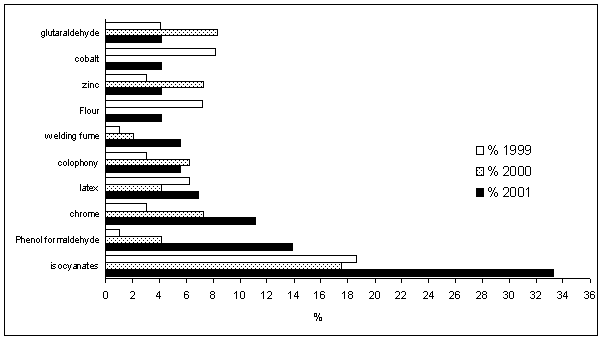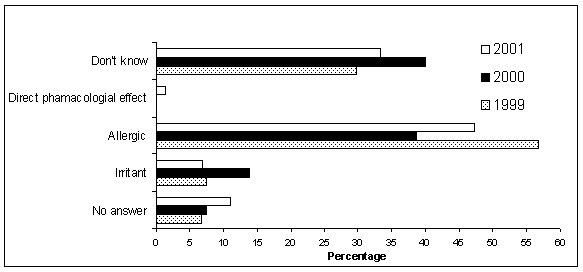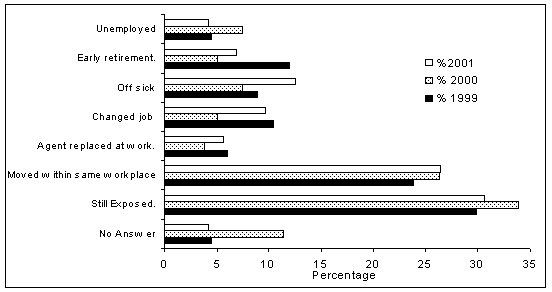Shield Report 2001; A Surveillance Scheme of Occupational Asthma in the Midlands |

|
V Huggins, W Anees, AS Robertson and PS Burge.
Occupational Lung Disease Unit, Heartlands Hospital, Bordesley Green East, Birmingham B9 5SS
SHIELD is the Midland Thoracic Society's Surveillance Scheme for Occupational Asthma for the West Midlands. The scheme, which was set up in January 1989, was established to study the general and specific incidence of occupational asthma within the West Midlands region and Metropolitan County. 72 reports have been received so far for 2001. The most common cause in 2001 was isocyanates (32%) and has been for the last ten years. 67% of cases reported in 2001 were by the Birmingham Chest Clinic and 33% by others, whereas in 2000, 22.5% of cases were being reported by other organisations, which may suggest an increase in awareness of the scheme. The most common method for the diagnosis of occupational asthma still remains a history of improvement of symptoms during holidays or periods off work. Some form of objective confirmation was made in 83% of patients.
Introduction
Shield is a joint project between the West Midlands branch of the Society of Occupational Medicine and the Midland Thoracic Society. The scheme, which was set up in January 1989, was established to meet three main objectives. 1) To study the general and specific incidence of occupational asthma within a defined geographic area, 2) To determine proposed mechanisms of asthma, and 3) to audit diagnostic methods and objectives. Chest physicians and members of the West Midlands Group of the Society of Occupational Medicine implemented the scheme, by reporting each new case using a questionnaire format. The questionnaire covers confidential personal information on the patient, details of the diagnosis, information about their occupational history, and the outcome after diagnosis.
The last report on Shields progress was written in 2000 and summarised the information gained in that year, to that of previous years, 1999 and 1995-98. This report aims to update the participants of Shield by summarising the trends found in 2001 compared to those found in 2000 and 1999.
Outbreak of the year
This year, 11 people have been reported to the Shield scheme from an aluminium casting foundry in the midlands. The cases have been notified as being either occupational asthma to isocyanates or phenol formaldehyde/resins. This particular company had no problems with occupational asthma until the employees started to cast large cylinder heads of 8 litres and over. When the cast cooled, it had to be pulled out of its die using overhead hooks, which meant having to move the extraction which was also above the cast, out of the way. On return to casting smaller cylinders with extraction back in place, the workforce was asymptomatic once more. The workers' occupations are a mixture of die-casters and core makers. They have been exposed for a maximum of 35 to a minimum of 9 years before their symptoms appeared, suggesting a long latency period. Due to the rapid change in symptoms when extraction was re-installed, the main cause of their occupational asthma is thought unlikely to be due to isocyanates; with isocyanate sensitisation low-level exposure usually provokes symptoms. None of the workers were clinically referred, the outbreak came to light after they decided to take legal action. Clinical referral and diagnosis should have lead to earlier remedial action.
Foundry workers have been a high risk group within the West Midlands for some time, we have previously had 49 reports, including at least 6 foundries with more than 1 reported case. The commonest cause is from the fumes during core making, or casting into moulds with cores (the cores provide the "holes" in a casting, for instance for cylinder blocks. Cores are made from sand and bound with a resin, commonly phenol formaldehyde (hot box), or isocyanates (cold box). Other reports have come from aluminium casting without cores when fluoride fluxes are used.
Agent awareness of the year
Glutaraldehyde notifications have decreased in number in 2001, now only being 4% whereas in 2000, 10% of notifications were due to this biocide. This fall could be due to better use of protective equipment when using the agent and an increase in health and safety awareness of the product. This is good news!!
Shield Data
Number of Cases
The number of cases of occupational asthma reported to the Shield scheme is 72 so far. When the SHIELD report for 2000 was written, there were 80 cases notified, but now this figure is up to 96, and is still rising. This means, that by 2003, we should have a similar number of reports for 2001 as 2000 if the trend follows the same route. It is difficult to compare notification for each year properly, as the last few years are likely to change, therefore the graph below is only as a guideline. The diamond shaped point is an estimate of how many notifications of occupational asthma there will be by 2003.
Figure 1 Number of cases diagnosed with occupational asthma between the years of 1980 and 2001.

Personal details
In the year of 2001, 72 new cases have been reported to the scheme so far. There were 48 males (67 %), and 24 females (33 %). 59 (82%) of the new cases had no pre-existing asthma, and 24 (33 %) had never smoked.
Reporting Hospital and Physician
The Shield scheme is confined to the West midlands Region and the West Midlands Metropolitan County. In this region there are many chest physicians, hospitals, clinics and other organisations, which are known to the Shield scheme. In 2001, 48 (67 %) of the cases reported to Shield were through the Birmingham Chest Clinic, and 24 (33 %) through other organisations. The percentage of cases being reported by the BCC has fallen over the last 3 years, from 87% in 1999, to 77.5% in 2000 and now even lower to 67% in 2001. This shows that other organisations (a combination of 34 different ones), are becoming more involved again, although the main contributor is City Hospital, Birmingham (22% in 2001).
Suspected agents at work
In 2001 the reported agents that the workers were exposed to had varied from the previous years. The most common in 2001 and previous years (except 1997) was isocyanates. 305 cases of isocyanate suspected asthma have been reported to the scheme, the first case being in 1978. 24 cases of isocyanate asthma were diagnosed in 2001 and 14 cases in 2000.
The top ten primary agents reported in 2001 were;
1) Isocyanates (33%),
2) Phenol Formaldehyde (14%),
3) Chrome (11%),
4) Latex (7%)
5) And 6) Colophony and Welding fumes (6% each)
7) to 10) Flour, Zinc, Cobalt and Glutaraldehyde (4% each).
Most of these agents were in the top ten of 2000, however, Oil mists, diesel fumes and wood dusts were featured in 2000, whereas in 2001, there were no reports for wood dusts or diesel fumes and only 1 for oil mists. On the other hand, Phenol formaldehyde did not feature in the top ten agents exposed in 2000, but is present now. This is probably due to the high number of foundry workers reported this year.
Figure 3 Comparison of the percentage of patients exposed to the top ten agents in 2001 to those exposed in 2000 and 1999.

Employers and Jobs
There were 54 different employers reported to the scheme in 2001, with 1 unknown. Around half of these were new to the scheme. The major outbreak for 2001 was at a foundry making cylinder heads and was due to either isocyanates or phenol formaldehyde. This particular outbreak accounts for 12.5% of all reports in 2001. In 2001 there was an outbreak in a car manufacturing company involving zintec.
44 different jobs were reported in 2001. The most common job was die-casting (11.1%) with welders running a close second at 9.7%, then nurses at 8.3% of all notifications for 2001.
Table 1 A list of the most common agents reported in 2001 with the corresponding jobs
| Agent Exposed |
Job |
| Chrome |
Chemist, warehouseman, metal sprayer, grinder, car assembler |
| Cobalt |
Grinder, metal sprayer |
| Colophony |
Coil winder, electrician, glue sprayer |
| Flour |
Baker, line supervisor (bakery) |
| Glutaraldehyde |
Nurse |
| Isocyanates |
Die caster, upholsterer, core maker, foam injection, motor body repairer, paint sprayer, packer, wreath maker, glue sprayer |
| Latex |
Nurse, operating department assistant |
| Phenol Formaldehyde |
Core maker, die caster |
| Welding Fumes |
Welder |
| Zinc |
Welder |
Methods used for diagnosis
The methods used for the diagnosis of occupational asthma vary between each hospital and each physician. The methods that are documented on the shield form are; 1) Improvement on holiday, 2) Improvement off work, 3) Serial peak flow charts, 4) Specific IgE, 5) Methacholine at work, and 6) Methacholine away from work and 7) Bronchial provocation tests. 69 cases were documented as improving off work and on holidays. Of these, 57 cases had at least one other investigation. The most common investigation was serial peak flow charts (52 cases) followed by IgE (33 cases). There were 18 challenges in total in 2001, but of these only 2 people were diagnosed in the same year. This is due to a backlog of people who were diagnosed in 1999 and 2000 needing challenging. In 2000, there was also 18 challenges performed, with 7 of these also being diagnosed in 2000.
Table 2 Percentage use of each method of diagnosing occupational asthma in 2001, 2000 and 1999.
| Method |
%2001 |
% 2000 |
% 1999 |
| Improving on holidays |
97.2 |
91.6 |
89.6 |
| Improving off work |
97.2 |
91.6 |
92.5 |
| Serial peak flow |
72.2 |
72.3 |
73.1 |
| Specific IgE |
45.8 |
41.0 |
56.7 |
| Methacholine at work |
23.6 |
26.5 |
26.9 |
| Methacholine away from work |
33.3 |
28.9 |
50.7 |
| Specific Bronchial Challenge |
2.8 |
7.2 |
7.5 |
Proposed method of asthma
Figure 4 shows the proposed mechanism of asthma in-patients with diagnosed occupational asthma in 2001 and 2000. In 2001 the most commonly reported mechanism of asthma was allergic 34 (47 %). In 2000 an allergic mechanism was also reported in most cases, however the overall percentage was less (38 %). The percentage of the cases where the mechanism is not known is slightly less in 2001 (33%) compared to the previous year (40 %), but the percentage of 'no answer' has decreased in 2001 compared to last year. The other mechanisms (irritant and direct pharmacological effect) still remain low in the percentage of proposed mechanisms.
Figure 4 Proposed mechanisms of asthma in 2001, 2000 and 1999.

Subsequent History
The subsequent history of the patients diagnosed with occupational asthma in 2001 is very similar to that of 2000 and 1999. A smaller percentage are still exposed at work, but more are off sick than in 2000. Relocation in the work place has increased and still remains the most popular solution. The percentage of 'no answer' has decreased from 2000. The recorded subsequent history of the patient is taken at diagnoses and may be changed as investigations occur, this means that the form should be updated and the true outcome for the patients diagnosed with occupational asthma in 2001 will not be seen until mid 2002.
Figure 5 Subsequent history of patients diagnosed of occ. asthma in 2001, 2000 and 1999.

Gold Standards
A gold standard occupational asthma case is defined by either; 1) Bronchial challenge test, 2) A four fold change in their bronchial reactivity with a good history, or 3) Positive IgE with a good history, and all of theses can be accompanied by a good quality PEF record. 12.5% of cases in 2001 were gold standards, which is slightly less than 2000. However, as gold standard is dependent upon the results of investigations it is likely that this will rise over the next year.
Future Developments
The problems with the Shield scheme are still lack of reporting and a need for constant updating. Other hospitals appear to be reporting slightly more each year though, especially City Hospital, Birmingham. The number of 'no answers' to questions implies that the results of further investigations are not being reported. To try and solve the above problems we have started to send a report of all the details back to the referring consultant. This enables the physician to complete the form as and when the investigations are carried out, and to send the form back when more information is added. Using this method it will be clear in the notes if the patient has been reported and at what stage the investigations are at whilst maintaining an up to date database.
Conclusions
Occupational asthma remains a serious disease causing much morbidity, and is potentially preventable This year a newly approved code of practice will be introduced by the Health and Safety Executive, with particular emphasis on the common causes of occupational asthma. Healthcare personnel amongst others are a high risk group for the development of occupational asthma.
Comments
Please sign in or register to add your thoughts.